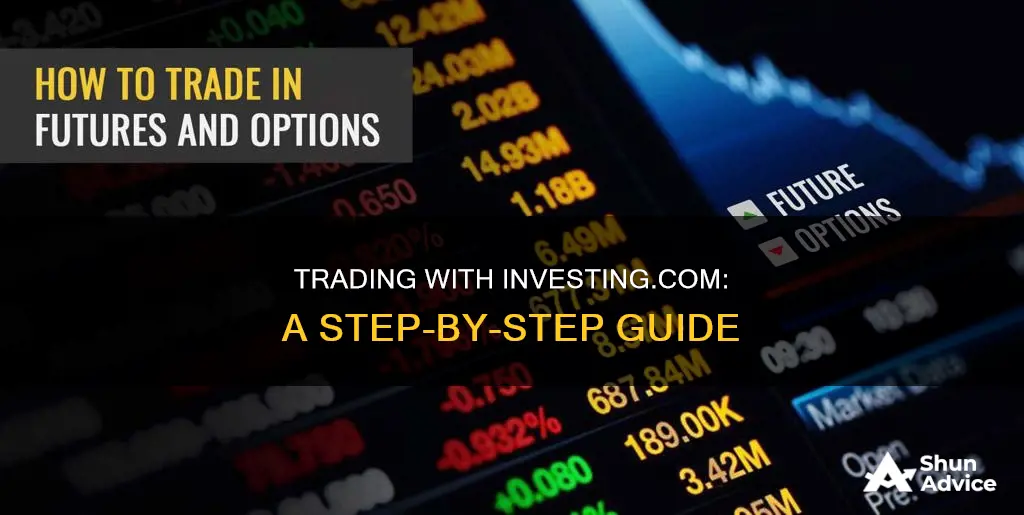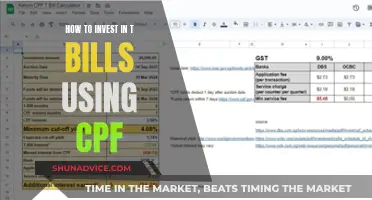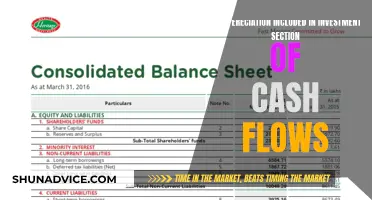
Investing.com offers a range of resources to help traders navigate the financial markets, including eBooks, webinars, and a Trader Accounts section. The website covers a variety of topics, such as trading stocks, CFDs, futures, and Forex, as well as fundamental and technical analysis. The Trader Accounts section provides detailed analysis tools, allowing traders to monitor and organize their trading activities, share their expertise, and learn from fellow members. Additionally, Investing.com offers educational content for both novice and experienced traders, emphasising the importance of understanding the markets before beginning to trade. The website also provides news and analysis on economic events, stock picks, and market movements to help traders make informed decisions.
| Characteristics | Values |
|---|---|
| Trading options | Online trading platforms, stockbrokers |
| Trading process | Buy low, sell high |
| Trading tools | Demo account, MT4 trading accounts |
| Trading resources | eBooks, webinars, news releases |
What You'll Learn

How to trade stocks online
Trading on the stock market is a popular investment option for both new and experienced traders. Before you begin trading, it is important to understand that buying a stock or share in a company makes you a part-owner in that business. Shareholders can benefit from dividends and profits from selling stock that has risen in value, but they can also make losses if the share price drops and they sell.
How to Become a Stock Trader
Anyone can become a stock trader with enough starting capital, time, and access to a trading platform or broker. Before you begin, you must decide how much time you will dedicate to trading and what levels of risk you are willing to take. If you are planning to trade stocks part-time alongside a full-time job, using a stockbroker could be the best option. Most brokers provide a range of services tailored to different levels of involvement: discretionary services, advisory options, and execution-only services.
If you want to buy and sell stocks yourself, you can use an online trading platform. As stock prices are constantly changing, there are a few main ways to buy and sell stocks and shares online:
- Instant trades: buying shares at the current price or selling at the best possible price.
- Agreeing a price: agreeing a price for buying or selling stock, with the trade executed when that price is met.
- Limit orders: an order executed immediately when an agreed price is met.
- Stop-limit orders: customizable trades where an activation price is set, which then turns into a limit order when that value is hit.
Using an Online Trading Platform
The essential principle of how to trade stocks online is still to buy low and sell high. You can use a demo account to practice trading before buying and selling stocks with your own finances.
Trader Accounts
You can also add your trading account to a Trader Accounts section, which provides detailed analysis of your trading activities and allows you to share your expertise with other users. This can help you to monitor and organize your account and gain a global reputation.
Understanding Cash Flow Driven Investing Strategies
You may want to see also

How to trade the news
Trading the news is a strategy that involves making decisions based on the impact of news events on the financial markets. It is a crucial skill for day traders and long-term investors alike, enabling them to capitalise on short-term fluctuations and make more informed trading decisions. Here are some key principles and strategies to help you effectively trade the news:
Understand the Impact of News on Markets
News events such as economic data releases, political developments, and company announcements can significantly influence market sentiment and create trading opportunities. Economic indicators (GDP, employment data, inflation reports), corporate earnings reports, central bank decisions, and geopolitical events are among the various types of news that can be traded. These events can affect markets in different ways, so it's important to understand their potential impact.
Timing is Critical
Knowing when specific news will be released is essential for positioning yourself accordingly. For example, if trading stocks, it may be wise to avoid holding positions during major economic data releases like monthly jobs reports or interest rate decisions. Having a strategy in place before the news release is crucial to avoid making rash decisions.
Reliable and Timely Information is Key
Trading the news requires a reliable and fast news source. Free news feeds often have delays of up to 30 minutes, which can be detrimental in quickfire trading. Consider investing in a real-time news subscription or utilising a broker that provides real-time news. Benzinga Pro, for instance, is a low-cost real-time news service that provides market-moving news and analysis.
Analyse and Interpret the News
Interpreting news is a skill in itself. Remember that news trading is not just about facts; it involves understanding how the public interprets the information. Consider the speed of news delivery, its impact on companies, and market perception when analysing news events. Additionally, don't forget that markets price in the future, so it's crucial to look beyond the present when analysing news.
Trading Strategies
Several strategies can be employed when trading the news, including:
- Breakout Trading: This involves looking for a period of consolidation before a major news release and then trading the breakout that occurs as a result of the news.
- Fading the News: This strategy involves taking a contrarian approach and making trades opposite to the market sentiment triggered by the news.
- Trading Based on Market Sentiment: This approach focuses on understanding market sentiment and making trades aligned with the prevailing market mood.
Manage Risk
Trading the news carries certain risks, such as unpredictable market reactions and increased volatility. It's important to have a risk management plan in place, including setting stop-loss orders and limiting position sizes to manage potential losses.
Stay Informed and Adapt
To effectively trade the news, it's crucial to stay updated with relevant news sources and economic calendars. Additionally, be adaptable as market conditions and news events can change rapidly.
Practice and Education
Trading the news requires knowledge and experience. Consider utilising educational resources, such as those offered by Investing.com, to enhance your understanding of trading strategies and market dynamics. Practise trading in a demo account to refine your skills before risking real capital.
Strategies for Investing in Cash ATMs: A Guide
You may want to see also

How to trade Forex on news releases
Trading forex on news releases can be challenging, but it can also be very rewarding. The forex market is open 24 hours a day, five days a week, and economic data is often the catalyst for short-term movements in this market. The release of economic data can cause large price movements, especially if the data is unexpected. Therefore, it is important to be prepared and know what to do when trading forex on news releases. Here are some key things to keep in mind:
Understand the Impact of News on Forex Markets
News releases can have a significant impact on the forex market, especially economic data from the US, as the US dollar is one side of many currency pairs. Economic data releases from other countries can also have an impact, especially if they are unexpected. It is important to keep track of when these releases occur and understand which data is most relevant to forex traders. For example, announcements that typically move the markets the most include interest rate decisions, inflation data, and economic growth figures.
Develop a Trading Strategy
There are several trading strategies that can be used when trading forex on news releases. One common strategy is to look for a period of consolidation ahead of a major data release and then trade the breakout that often occurs after the news is released. This strategy can be used on an intraday basis or over several days. Another strategy is to use exotic options, such as double one-touch or double no-touch options, which can help capture a breakout in volatility while reducing the risk of a reversal.
Be Mindful of the Broader Economic Environment
It is important to consider the broader economic environment and market trends when trading forex on news releases. For example, in the post-pandemic years, traders have been paying close attention to inflation and interest rate decisions, which have had a significant impact on currency values. Understanding the current economic backdrop can help traders make more informed decisions when trading on news releases.
Stay Informed and Act Quickly
Trading on news releases requires quick decision-making, as financial markets can be impacted almost immediately after a news release. It is important to stay informed about upcoming economic data releases and market expectations. Additionally, combining fundamental analysis with technical analysis can help traders make more informed decisions. Fundamental analysis involves understanding the economic factors that impact financial markets, such as interest rates, inflation, and unemployment levels. Technical analysis involves analysing price charts and using various indicators to identify potential trading opportunities.
Manage Risk
News-based trading can be risky, as it requires expertise in fundamental analysis and can result in carrying positions for longer periods. It is important to understand how economic announcements can affect your positions and the wider financial market. Additionally, traders should ensure they have sufficient funds to cover any additional holding costs that may arise when positions are held overnight or for extended periods.
Cash Value Investing: Strategies for Long-Term Wealth Preservation
You may want to see also

How to use fundamental analysis
Fundamental analysis is a cornerstone of investing and a method of determining a stock's intrinsic value. It involves examining a company's financial statements and broader economic indicators to uncover a security's value. This analysis gives investors the investment's true worth based on a company's financial health, the market, and economic conditions.
The result of a fundamental analysis will indicate whether a stock is undervalued or overvalued. If the fair market value exceeds the market price, the stock is undervalued, and a buy recommendation is given. Conversely, if the fair market value is lower than the market price, the stock is overvalued, and investors may opt not to buy or even sell if they already hold the stock.
Fundamental analysis is a longer-term strategy, often taking months or years, and is best suited to buy-and-hold investing. It is a useful tool for investors to look beyond short-term price fluctuations and focus on the underlying factors that drive a company's operations and long-term performance.
To conduct a fundamental analysis, you will need to study the company's revenue growth, profitability, and competitive advantages within its industry. You will also need to assess broader macroeconomic factors, such as the overall state of the economy and the demand for the company's products or services.
- Start with the CEO's letter to shareholders: Gain an overview of the company's performance, key developments, and outlook from top management.
- Review the business description: Understand the company's main products or services, target markets, competitive advantages, and key risks.
- Analyze the management's discussion and analysis (MD&A): Look at the company's financial performance, including revenue and expense trends, cash flows, and key financial ratios.
- Examine the financial statements: Review the income statement, balance sheet, and statement of cash flows. Calculate and assess key ratios such as the price-to-earnings (P/E) ratio, earnings per share (EPS), return on equity (ROE), and debt-to-equity (D/E) ratio.
- Read the notes to the financial statements: Gain additional details and explanations about the company's accounting policies, significant transactions, and other important information.
- Review the auditor's report: Obtain an independent opinion on the accuracy of the financial statements.
- Analyze the company's corporate governance: Consider the board of directors, executive compensation, and other corporate governance matters.
- Look for additional disclosures: Review legal proceedings, regulatory issues, or environmental, social, and governance (ESG) factors that could impact the company's performance and reputation.
In addition to these quantitative measures, fundamental analysis also considers qualitative factors, such as the quality of the company's management team, brand awareness, and potential for growth and profitability.
Selling Investments on Cash App: A Step-by-Step Guide
You may want to see also

How to trade using a broker
Trading using a broker can be a great way to get started with investing. Here's a step-by-step guide on how to trade using a broker:
Step 1: Understand the Basics of Trading
Before you begin trading, it's important to understand the basics of stock trading. Buying a stock or share in a company makes you a part-owner of that business. As a shareholder, you can benefit from dividends and profits when you sell stock that has risen in value. However, there is also a risk of making losses if the share price drops and you sell.
Step 2: Decide on Your Trading Style
Different trading styles suit different personalities, risk tolerances, and time commitments. The three main trading styles are day trading, swing trading, and position or long-term trading. Day trading involves rapid decisions and constant attention to the markets during trading hours, making it more suitable for those with a higher risk tolerance and more time to dedicate. Swing trading and position trading allow for longer holding periods and require less time commitment, making them a good choice for those with less time to dedicate to market analysis.
Step 3: Choose a Brokerage and Open an Account
When choosing a brokerage, look for one that aligns with your trading style and offers the tools, resources, and support you need. Consider factors such as platform features, research resources, user-friendliness, and pricing. Once you've selected a brokerage, open an account by providing your personal information, choosing your account type, and funding your account.
Step 4: Research and Analyze Stocks
Before investing, research the stocks you're interested in by analyzing the company's fundamentals, including financial health, competitive position, and growth prospects. Combine fundamental analysis with technical analysis, which involves studying past prices and volume data to identify trends and patterns. Monitor news, investor sentiment, earnings reports, and geopolitical or macroeconomic events that could impact the company or industry.
Step 5: Place Your Orders
When you're ready to trade, specify the stock ticker symbol, the number of shares you want to trade, and the type of order you want to use. There are several types of orders to choose from, including market orders, limit orders, and stop orders, each with its own advantages and risks. Always double-check the details of your order to avoid costly mistakes.
Step 6: Manage Your Risk
Implement effective risk management strategies to protect your capital, limit losses, and improve your trading performance. Diversify your investments across stocks, sectors, and asset classes to reduce the impact of any single stock or sector underperforming. Maintain emotional discipline by sticking to your trading plan and avoiding impulsive decisions. Consider more advanced risk management techniques such as hedging and position sizing as you gain more experience.
Investing Anonymously: Strategies to Invest Without an SSN
You may want to see also
Frequently asked questions
Investing.com offers a Trader Accounts section, which is a gateway to direct access to in-depth information on MT4 trading accounts. All Investing.com members can add MT4 trading accounts for free to track, analyze, and share their trading activity with the global audience.
The Trader Accounts section provides traders with detailed analyses of their trading activities and the ability to share their trading expertise with Investing.com users. The advanced functionality of the analytical tool allows you to use customized filters to easily personalize search results when accessing this extensive resource.
Investing.com offers a financial trading guide that includes 7 eBooks, written by top experts in the financial markets. The eBooks cover Forex, CFDs, and stocks trading, catering to both novice and experienced traders.







